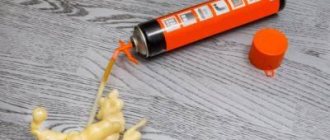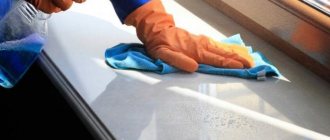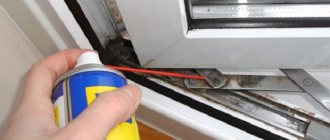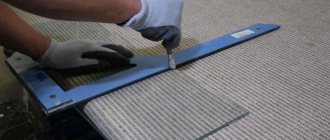Polyurethane foam is used today to seal a wide variety of structures. Its properties allow it to fill all voids as efficiently as possible and create a layer of material with excellent insulating characteristics. But often the foam ends up in the wrong place, and removing it without a trace becomes quite difficult. Below we want to talk about how to remove hardened polyurethane foam from a variety of surfaces.
Why is polyurethane and construction foam so difficult to remove?
To understand the reason, let's go through some of the properties of this useful material. First of all, high adhesion attracts attention. This means that the polyurethane foam adheres extremely successfully to almost all surfaces, be it plastic, metal, stone or wood. The second property that makes it difficult to remove is its resistance to moisture and many chemical influences. Consequently, softening the structure of the polyurethane foam after it hardens will be very difficult.
Methods for removing sealant
Before using any cleaner, first test it on a small, inconspicuous square and wait a while. If there are no changes in the material, then the mixture can be applied.
Chemicals
Special cleaners - they are usually produced by the same manufacturers as construction foam. It has been noticed that products for removing contaminants from just one line are most effective. Just be sure to read the label, which clearly states what surfaces it can be used on. And strictly follow the instructions.
Solvents - this group includes “Acetone”, White Spirit, “Solvent 646” and similar substances. They are effective on fresh marks.
Dimexide is a pharmaceutical drug that costs a penny. It destroys the structure of polyurethane foam and allows it to be removed. It is quite aggressive, so you need to wear gloves when working.
Vegetable oil - softens a thin layer of foam, so that it can be wiped off with a rag or spatula.
Vinegar is effective for combating fresh stains.
Water - despite the fact that you should not wet the newly applied composition, it will be an excellent assistant for softening the hardened layer.
Mechanical impact
Cleaning up residues is done using a knife, scrapers, spatulas and similar tools. As a rule, such an effect is not enough, and some techniques have to be used to soften and dissolve the polyurethane foam. However, pre-cleaning will help speed up the process significantly.
Sanding - this method is used when you need to remove a stain from some materials. For example, it is easier to quickly rub a concrete floor with sandpaper than to torment it with chemicals for a long time and to no avail. A similar technique is also used if chemistry does not help.
How to remove polyurethane foam that has not had time to harden
If you notice the fact of contamination in time, the situation becomes much simpler. In the case of soft foam, physical impact is sufficient to remove it. The ideal solution would be a spatula. But it is necessary to work with the latter extremely carefully, as otherwise the surface can be damaged. In extreme cases, you can use a knife.
However, with this action, the foam can still leave marks, since it sets on the surface very quickly. As a result, it will have to be dissolved. And we'll talk about this further.
Compositions suitable for removing foam
Solvents for specific purposes
Almost every major manufacturer of polyurethane foam also produces an accompanying product for cleaning construction guns, which is also successfully used to clean surfaces and clothing from polyurethane foam that has fallen on it. When purchasing foam from a certain company, it is recommended to immediately buy a solvent from the same manufacturer, since it will definitely become an effective means for cleaning tools and various surfaces.
Another factor to pay attention to is the effect of the cleaner, as some formulations are designed to remove foam that has just hit the skin or objects, while others are designed for long-standing stains. In addition, when purchasing a solution, you should study its characteristics, since some of them negatively affect certain materials that foam can get on.
Several examples of cleaners widely available on sale will be presented in the table:
| Illustration | Brief description of the compositions |
| “IsoFoam R621” is a domestic product specially designed for removing fresh stains from polyurethane foam, removing it from skin, clothing, and also washing mounting guns. This is the most affordable product that should be on hand when renovation work is being done in a house or apartment, as it will help clean the surface not only of foam, but also of paint or varnish. This cleaner is suitable for all types of foam. | |
| "Cosmofen" is another cleaning composition manufactured by a foam manufacturing company. However, it should immediately be noted that this solvent is produced in four versions, each of which has its own number - “Cosmofen” No. 5, 10, 20 and 60. Only composition No. 5 ; other options are used for other purposes. If “Cosmofen 5” , then before applying it to the surface, it is necessary to test the resistance of the material to this composition. "Cosmofen 5" is suitable for removing only fresh stains. It is applied to the contaminated surface, wait a few minutes, then wipe off with a dry cloth, running it in one direction. It is not recommended to use this product in rooms with high humidity, as its effectiveness is reduced. "Cosmofen 5" effectively removes foam stains from plastic surfaces and linoleum. | |
| “Macroflex Cleaner” is a cleaning product that is highly effective in dissolving fresh polyurethane foam and cleaning contaminated surfaces from it, as well as for washing the mounting gun immediately after completion of work. This composition is not effective for dried material. “Macroflex Cleaner” is also used to wash a clean gun, which is recommended every two to three months to maintain it in working condition. The product can damage some materials - polished and painted surfaces, plastic parts, and some fabrics. Therefore, when carrying out work, it is necessary to protect clean, uncontaminated areas from the negative effects of the solvent. | |
| "ULTIMA Professional" is a universal cleaner for cleaning various surfaces and clothing, as well as tools from uncured polyurethane foam. In addition, the composition is used for applying it to glass and metal before using polyurethane foam or sealants - this greatly facilitates the removal of contaminants after work. ULTIMA Professional is a fast-acting product, but it does not melt or leave marks on plastic materials. | |
| Penosil Premium Cured PU-Foam Remover is a cleaner designed to remove hardened polyurethane foam from various surfaces and clothing items. However, it must be used extremely carefully, since it is a very aggressive solvent that affects not only the foam, but also the paint and varnish applied to certain objects. Therefore, it is recommended to carry out a test first by applying the composition to a small area of the item being cleaned, so as not to completely damage its surface. |
To use one of the presented compositions or similar means for cleaning surfaces, you need to remove the protective cap and install the spray head that comes with the cleaner (the same as on most standard aerosol cans). By pressing this head, it is necessary to treat the contaminated areas with a solvent, leave them for a certain time (indicated by the manufacturer on the packaging), and then wipe off the “floating” polyurethane foam with a napkin.
First, the gun adapter is cleaned using a spray head. The head is then removed, the can is screwed onto the adapter, and solvent is forced through the gun to remove any remaining foam from the inside.
If it is necessary to clean the mounting gun after work, instead of foam, a bottle of cleaner is screwed into its adapter. Then the lever is pressed several times so that the flushing agent passes through the gun tube, releasing the remaining foam until a clean solvent appears.
Craftsmen always try to simplify a task and make it cheaper to complete. See, for example, how you can make your own and how to then use a home-made device for better washing of a spray foam gun.
Video: Washing a spray foam gun using a homemade device
It makes sense to recall a few key safety rules for working with professional products sold in sealed containers. Not only are solvents flammable. They are also in a pressure cylinder, so the following rules should be observed:
This fully applies not only to the washes under consideration, but also to all pressure cylinders in general. Here, for example, is what can happen if a cylinder of polyurethane foam transported in a car overheats...
- Do not leave the cylinder in direct sunlight or in places where it can heat up to a temperature of 45-50 degrees. Moreover, the danger is posed not only by full cylinders, but also by those that, in the opinion of the master, are already empty and used.
- It is strictly forbidden to try to open any container, even an empty one, or to throw it into a fire.
- It is unacceptable to work with flammable solvents near open fire sources, or to smoke near or in a room where any operations with such compositions are performed.
- Work should be done in a respirator, safety glasses and gloves - this will reduce the likelihood of washable foam residues getting on the surface of the skin or eyes, and unsafe solvent fumes getting into the respiratory mucosa.
- The room where such construction work is carried out must be well ventilated. In the absence of effective ventilation, a concentration of volatile solvent vapors that is dangerous from the point of view of both toxicity and fire may accumulate.
Naturally, when carrying out such work, it is necessary to ensure that children do not enter the room. And any construction aerosol cans should be kept completely out of reach of curious children's hands.
Common solvents for painting work
In addition to professional products specifically designed for cleaning foam, other solvents known to all builders are used for similar purposes - white spirit, kerosene, gasoline, turpentine and acetone. These compounds are also flammable liquids, so when working with them, you must fully comply with all the safety rules listed above.
White spirit is both a solvent and a cleaner.
- White spirit is a composition that is used to dissolve paints and varnishes, as well as to remove paints and varnishes from hands and clothing. Using white spirit, you can dissolve thickened drying oil, bitumen compounds, alkyd, enamel and oil paints, glypthal and pentaphthalic varnishes. It is prohibited to add white spirit to solutions containing water, water-soluble alkali, or acids.
White spirit will also help with fresh stains of polyurethane foam; it will also help remove old stains from some surfaces.
Other solvents based on petroleum products - gasoline or kerosene - can have approximately the same effect as white spirit.
To remove foam from fabric, acetone or solvents based on it are often successfully used.
- Acetone is also a very aggressive solvent for many paints and varnishes, and is especially nitro-based. Quite often, acetone helps to dissolve foam. However, acetone is quite an aggressive agent, so it can destroy the texture of the material, leaving a faded stain, for example, on fabric, linoleum or laminate. Therefore, this substance should be used very carefully.
Turpentine is one of the most famous means for cleaning surfaces from paints. It also helps with removing remnants of polyurethane foam.
- Turpentine is a solvent known for a long time, used to remove various stains, including those left on surfaces from polyurethane foam. These types of solvents are not too aggressive, so they will not damage or discolor the surface or fabric, or burn the skin. The products may leave greasy stains on the fabric, but they can be washed off with detergents.
Folk remedies
There are other compounds that are not, in fact, solvents and are not directly intended for removing foam. However, their ability to clean surfaces was experimentally identified.
- Such products include vegetable oil, the inexpensive and over-the-counter drug "dimexide", alcohol mixed with salt and diluted with water, soda in combination with the above-mentioned solvents.
- There are also some completely unusual recommendations. For example, such that foam that gets on clothes can be easily removed by placing the fabric in the freezer. However, this must be done extremely carefully so that the polyurethane does not smear on its surface.
The fabric on which the foam has fallen should be placed in the freezer, being careful not to disturb the size and shape of the stain or to smear it.
- Another option that works great in some cases is to remove the foam completely mechanically, without using any compounds. That is, first, most of the mass is removed, and traces of it are carefully cut off with a blade. However, this method is only suitable for hard and smooth surfaces.
Now that we have considered the main means of getting rid of polyurethane foam, it is necessary to consider which surfaces and what compositions can be applied to in order to obtain the desired effect, as well as where contaminants can be removed mechanically.
What to do if the polyurethane foam has already dried?
Let's turn to polyurethane foam solvents. They must be special, since ordinary solvents will not work. These are:
- Phenozol;
- Cosmofen;
- Reiniger
In general, there are many similar solvents on the market now. But some people use the medicine Dimexide, which is sold in pharmacies without a prescription.
Whatever you use, you must first cut off the bulk of the foam, leaving only a piece adjacent to the surface. After this, you can expose it to a solvent.
Important! It is possible to influence the foam in this way only in the case of a surface that is resistant to acetone. At the same time, you should not delay cleaning, since such a chemical component can damage even a stable surface if given enough time.
The action of the solvent or Dimexide causes the foam to soften, which makes it easy to remove.
Mechanical cleaning methods
If you don’t have a professional “tool” at hand, you can get rid of the foam on the gun using mechanical methods. But they are only suitable for external cleaning. Take a metal brush, knife or scraper. First, cut off the large dried pieces. Then scrape off the remaining areas with a sharp object. When finished, sand down with sandpaper.
Disassembling the gun for mechanical cleaning
It is inconvenient to clean the device using mechanical methods, so they are used in extreme cases. If there are large pieces of dried building material on the gun.
The nuances of removing dry polyurethane foam depending on the type of surface
The dissolution method mentioned above works with almost all surfaces. In some cases, simple gasoline, acetone or even vegetable oil helps. If we are talking about linoleum, then in this case you can even handle it with water. Simply wet a cloth and place it on the contaminated area of the surface. The foam will soften. Unfortunately, this method will not work with laminate, and it is better to use a solvent or the same Dimexide.
Polyurethane foam often gets on your hair. And in this case, most likely, you will only have to cut them off, since it is almost impossible to remove such contamination. But with the skin it’s a completely different matter - in a maximum of a few days the foam will go away on its own.
What do you need to remember about the rules for working with foam?
When starting to perform certain operations with polyurethane foam, you should know certain nuances that will help you avoid foam getting on surrounding objects or allow you to remove it without problems.
- The work area - floors, furniture and other objects should be protected with film or newspapers.
When working with foam, it is recommended to protect your hands with gloves.
- Hands should be protected from foam getting on the skin with gloves.
- If you are performing a large-scale task, it is recommended to wear clothes that you don’t mind ruining. Well, or at least use a plastic apron, which you can then throw away without regret.
- Hair should also be protected with some kind of headdress, maybe even an improvised one - a scarf, Panama hat, bandana, etc.
- It is advisable to always have a polyurethane foam remover on hand. The faster you can use it, the better and more “painless” the cleaning of skin, clothing, and other surfaces will be. If the foam has time to set or be absorbed, then it will be much more difficult to clean it.
- If foam gets on any surface, you must try to remove it so that it does not smear. This can be done, for example, carefully with a narrow spatula. Then the remaining dirt must be immediately filled in or wiped with the selected cleaner. It is difficult, and sometimes even impossible, to remove foam that has been spread in a thin layer and has penetrated into the structure of another material.
It is best to remove foam from laminate immediately after contact.
- If the foam hits a surface that does not absorb moisture and other substances in one compact drop, then it would be better to wait for it to dry completely. Once the polyurethane foam expands, it can be easily cut or simply torn from concrete, polished surfaces, and even from some fabrics. However, this method is not suitable for laminate and linoleum, since the foam adheres to these materials very well and can damage the protective layer of the coating when it is torn off. Therefore, it is better to remove it immediately after contact.
- Do not try to wash your hands, tools or any surfaces contaminated by polyurethane foam in the usual way. The foam hardens quickly when exposed to water, and it will then be even more difficult to clean it off.
So, it is best to prevent foam from getting in at all. But, alas, it doesn’t always work out that way. Therefore, it is necessary to use compounds designed to remove foam and use proven methods for cleaning various surfaces from such contaminants.
How to remove polyurethane foam in a cylinder fitting pipe
Sometimes foam gets stuck in the pipe fitting of the cylinder itself. Many people throw away the container itself, although there may still be a lot of foam that is quite suitable for use and has not lost its effectiveness. And in order to get it out, you need to try to rotate the fitting itself clockwise. This is best done with pliers. If the rotation succeeds, then the balloon can be revived, but if not, then all that remains is to throw it away.
After this, you need to try to screw a self-tapping screw into the foam stuck in the fitting. Having done this, you need to sharply pull out the screw along with the foam, and then check the fitting for air passage by pressing on it.
Now all that remains is to clean the tube itself, which usually has a straight and curved section. Having separated them for more convenient work, you can try to clean the foam with a wire. As a rule, there is nothing complicated in this case.
How is cleaning done?
How and with what to wash foam from hands?
This question is most often found on the Internet, since most inexperienced builders begin working with foam without protecting their hands with gloves.
If such a situation occurs and fresh polyurethane foam has just come into contact with the skin of your hands, you should immediately take the following measures:
Foam can be removed from the skin of your hands in different ways, depending on its amount and degree of hardening.
- The first thing to do is to carefully remove the bulk of the foam, without spreading it to adjacent areas of the skin. You can use a spatula for this. If you have an assistant nearby, you can use two spatulas, picking up the foam from both sides.
- Immediately after this, one of the professional products should be applied to the remaining foam and immediately wiped off along with the polyurethane with a dry cloth. If it was not possible to remove all the foam in one approach, the procedure should be repeated. Then wash the cleaned area with soap and water and a brush.
- If the foam gets on a large area of skin, you should take a cloth, apply vegetable oil to it and carefully, slowly, try to collect the foam from the edges to the center. After this, you need to take a narrow spatula and try to collect most of the foam with it, then apply a solvent to the fabric and begin to scrub off the remaining polyurethane. The skin should then be washed with soapy water.
If the foam on the skin of your hands has already hardened, experts who have encountered this problem advise taking the following measures:
- An effective and fairly quick remedy, and most importantly safe, is the use of saline solution. To soften the frozen foam, hold your hands in salt water for 10–15 minutes. After this, you need to clean off the foam using pumice. Then just dry your hands with a towel and lubricate with an emollient. Regular baby cream or Vaseline oil is suitable for this.
“Dimexide gel is affordable and softens dried foam on hands well
- "Dimexide-gel" is a medication and can be bought at any pharmacy. The gel has the property of softening polyurethane foam, making it easily removed from the skin.
Baking soda and vegetable oil are used for various needs, including for cleaning foam from skin.
- Vegetable oil and soda. It will take some time for this mixture to act on the hardened foam, since it will not work instantly. To prepare the “cleaner” you will need five tablespoons of soda, to which you need to add oil heated to a warm state, and then prepare a liquid slurry from the two components. The soda in this product will act as an abrasive.
The mixture is applied to the contaminated area of skin and rubbed into it. Then it is applied to a cotton swab and applied to the hand, covered with a clean cloth and closed with a plastic bag or cling film. You need to keep this lotion for 25-30 minutes. Then you need to remove it, wipe the contaminated area again, and then wash it with warm water and soap.
- Kerosene, acetone or white spirit. Before using these products, it is necessary to remove most of the foam from the skin. After this, you should moisten the cloth in one of the mentioned solvents and rub your hand with the remaining foam. However, these products are not suitable for everyone, as they can cause an allergic reaction, and this also needs to be kept in mind. These compounds should be used outdoors, as they have a specific odor.
- You can use professional cleaners to dissolve dried foam if you are not allergic to them. Most of the frozen mass should be cut off, if possible, and then apply the product to your hands, wait a few minutes and wipe off the dirt with a cloth. After which you need to wash your hands well with soap.
All these procedures are not very pleasant, so it’s better not to let it get to that point. But it’s even worse if foam gets into your hair during work.
How to clean hair from foam?
If polyurethane foam accidentally gets on your hair, it should be removed immediately, since once it hardens, it will not be possible to clean the mass; in this case, there is only one way out - a haircut.
So, you can clean your hair from fresh foam as follows:
- If the hair is long enough, then it is necessary to separate the contaminated part from the rest of the hair. Using a toothed comb, you need to start combing out the foam, continuing to do this until they acquire relative softness, and they will acquire it when the glued curl is divided into individual hairs. Solvents should not be used, as if they get into your eyes or facial skin, you can get a serious burn.
"Dimexide" will help soften the foam, making it easier to comb out
- If it was not possible to completely comb the polyurethane out of your hair, you should use liquid “dimexide”. It can make the foam softer, which will allow it to be removed completely. This product has an unpleasant odor, but it will not cause any harm to your hair or health.
- At the end of the cleansing procedure, the head should be washed with shampoo several times.
Very important note. Liquid “dimexide” is a powerful anti-inflammatory leaf remedy that very actively penetrates human skin - this is essentially what the “technology” of its medicinal use is based on. But if you use it as a foam solvent, and do not protect your hands with gloves, you can get very unpleasant consequences, since it will “pull” the dissolved polyurethane foam through the skin. Caution and extreme care should be taken!
Removing foam from fabric
The most difficult thing to clean from foam is fabrics, since when it gets on them, polyurethane is immediately absorbed into their fibers. Therefore, contaminant removal is usually carried out in several stages:
Jeans cleaned with liquid dimexide
- If the foam has dried and has a fairly large volume, then first of all most of it should be removed by cutting. You can use a utility knife for this. You must work extremely carefully so as not to “stripe” the fabric itself - a small layer of foam is left on the surface.
- Next, you should use a professional solution to remove dried foam, gasoline, white spirit, kerosene or liquid dimexide. Either of these solvents is applied to the remaining foam and left for five minutes.
- The next step is to rub the fabric until the layer of foam is removed - just as is done during washing.
- For thin fabrics it is better to use “dimexide”, since a real solvent can damage it.
- After cleaning the foam, the clothes should be washed in the washing machine.
It is a little easier to deal with foam that has just hit the fabric and has not yet had time to penetrate its structure. In this case, the item of clothing, as mentioned above, can be placed in the freezer to freeze the foam, after which it can easily be separated from the fabric.
Foam on clothing
If, after freezing and removing the bulk of the foam, a trace of it still remains on the fabric, then it must be treated with a solvent. The item of clothing should then be washed as usual.
Another option to get rid of fresh foam if a small area is contaminated with it is to try to remove it from the fabric with a spatula or an old credit card. The remaining traces of foam can be wiped off with dimexide, gasoline or kerosene. It is not advisable to use acetone, as it lightens the color of the fabric, so it is possible that a whitish spot will remain on it.
How to clean foam from different materials?
For different surfaces, different means are used to clean them from polyurethane foam. For example, if foam gets on a surface made of metal, concrete or stone, then aggressive solvents or professional cleaners are suitable for cleaning it. If it is necessary to remove polyurethane foam from plastic parts or surfaces, it is recommended to use softer compounds - “dimexide” or one of the professional products designed specifically for cleaning plastic.
As mentioned above, the easiest way is to remove foam that has not had time to completely harden and adhere to the surface. When cleaning polyurethane foam from a window sill, door and other objects, you should wear gloves so that you don’t have to scrub it off with your hands later.
Whatever surface the foam gets on, most of it should be removed mechanically using a spatula or a sharp knife. Its remnants are removed using one of the suitable means:
Varnished wood piece contaminated with foam
- Wooden varnished or painted parts can be easily removed from both fresh and dried foam using dimexide. Under no circumstances should you use acetone for this purpose, as it can damage the varnish.
- Uncoated wooden surfaces can be cleaned using professional cleaners, choosing a product depending on the condition of the foam. Then clean the wood with sandpaper and sand it.
- Remains of frozen foam can be removed from a metal surface with vegetable oil, applying it with a sponge and leaving for a few minutes. After such a pause, the contaminated area must be rubbed with a hard dish sponge. To ensure that no greasy stain remains on the metal, the surface will then have to be washed with a soapy solution.
Removing foam residue from a plastic window using a spatula
- Plastic surfaces, in particular PVC windows and doors, should be cleaned with dimexide or one of the professional products suitable for this. When purchasing a cleaning solvent, pay attention to what surfaces it is intended for cleaning.
- There is also a mechanical method for cleaning a plastic surface from frozen foam. Most of it can simply be torn off by hand, and the remaining trace of it can be carefully cleaned off with a metal spatula or blade.
- The remnants of fresh foam that have fallen on the plastic, after removing the main mass with a spatula, can be wiped off with vinegar.
Cutting off polyurethane foam residues from glass
- Glass can also be cleaned without resorting to various solutions and cleaners, using a regular blade, which can easily cut off the remains of hardened foam from a smooth surface.
Foam experimentally applied to linoleum is easier to remove when frozen
- Linoleum and laminate. The foam does not penetrate into the structure of this material, but is well fixed on its surface, especially in cases where the linoleum has a relief pattern. It is better to remove foam from this floor covering after it has completely hardened. The main frozen mass is cut off with a knife, and it is better to remove the remains from the relief coating with Dimexide. The composition is applied to the dirt and left for 15-20 minutes, then wiped off with a cloth. After this, the linoleum should be washed with soapy water.
* * * * * * *
In conclusion, it should be noted that there are quite a few options for getting rid of the foam that gets in. However, if most of it is removed from the surface immediately, before penetrating into the structure of the material, it will be much easier to clean it.
And the best “way to clean” is to not let the foam get on any surfaces where it shouldn’t be.
At the end of the publication, there is a video about available ways to get rid of dirt from polyurethane foam.
Remove with chemical cleaning agents
Chemical agents that contain aggressive components show fairly high efficiency (depending on the cleaning technology used)
Acetone-containing products , such as nail polish remover, or acetone . The aggressive composition of acetone allows you to effectively remove fresh stains; hardened stains may be difficult to deal with; exposure will be required for 15-30 minutes. Acetone is not suitable for all surfaces. The product can be harmful to plastic surfaces; use the product carefully when dealing with stains on your hands; acetone dries out the skin and can cause an allergic reaction.
Slightly soluble cleaner Cosmofen 10 1 l. Photo by Leroy Merlin
White spirit is an organic solvent and a fairly universal product. White spirit is used to remove fresh and hardened stains from metal and plastic elements; it is suitable for exposure to fabric, but it may change color and destroy the structure of the material, depending on the type.
Cosmofen helps get rid of frozen contaminants from oil, glue, and polyurethane foam. It is also effective against fresh polyurethane. The product is actively used by installers of plastic windows and doors. Since the product is designed specifically for working with plastic surfaces. But it is also suitable for removing dirt from elements made of other materials. Cosmofen is sold in different concentrations; the lower the number on the package, the more concentrated the substance contained in the container.
Petrol. It is important to use refined gasoline. The product is suitable for removing fresh and dried stains. An alternative is kerosene. The products are suitable for working with various surfaces, as well as for removing polyurethane from fabric (clothing) and hands. Due to the strong odor of the substances, it is necessary to thoroughly wash your clothes and wash your hands after completing the cleaning work.
Solvents , products numbered 646 and 647 . The products will help with cleaning floors, uncoated metal surfaces, and clothing, but the substances should not be used on plastic, siding, PVC, MDF, or leather. Solvents can change fabric colors, discolor, damage structure and deform fabrics. Therefore, it is recommended to test the product for surface or fabric safety.
Carrying out work with aggressive agents requires the use of personal protective equipment and compliance with safety rules, in particular, manipulations should be performed in well-ventilated areas or in the open air. Depending on the state of contamination, exposure to substances of varying duration is required . Fresh stains are removed immediately; no special effort is required. But frozen contaminants require prolonged exposure, in most cases for no more than 30 minutes.
Main
- Before installation work, cover everything in the room with film or oilcloth and remove valuables. Wear old clothes and cover your skin.
- If traces of foam remain on the surface, remove them immediately with a solvent or folk remedy. Fresh stains are easier to remove than dried ones.
- Use a knife to scrape off foam only from wooden surfaces. Clean any other materials with a hard sponge.
- Before purchasing a professional solvent, read the instructions on the package: it will indicate for which surfaces it is suitable.
If it gets on an acrylic bathtub, what and how to remove it?
Acrylic coating requires delicate cleaning . Therefore, it is not recommended to use solvents, abrasive powders, metal spatulas, knives and blades, gasoline, ammonia, or chlorine-containing products. These tools and substances may damage the coating or destroy the structure of the product . If polyurethane foam gets on the surface of the bathtub, it is recommended to wait 20-60 minutes until the composition hardens, this makes it easier to clean off. The bulk is carefully cut off with a knife. To remove residues, it is possible to use vinegar essence (for a better effect, a rag can be left on the dirt), a solution with salt, and cleaners.
sunlight
In this case, two factors work on the problem of eliminating the consequences of careless handling of polyurethane foam - UV radiation and time. Polyurethane foam is afraid of ultraviolet radiation - it inevitably destroys its structure.
This method is more applicable for cleaning clothes damaged by polyurethane foam. If the time limit allows, then stained jeans, a T-shirt, and overalls should be hung out in the open sun. Over time, the foam turns yellow and begins to crumble, becoming pliable for mechanical removal by kneading or using a brush.
You can fail with this cleaning method only in two cases: either the polyurethane foam has penetrated so deeply into the fabric that the sun’s rays simply cannot reach it, or you do not have the patience to wait for this process to complete.
Polyurethane foam has become one of the most used materials in construction work. Without it, no one will probably be able to quickly and efficiently install a window or door or seal the seams in the wall. But what to do if it gets on the product itself, the wall, clothes or hands? How can I wash polyurethane foam while keeping the surface in good shape and in good condition?
White Spirit
Produced by distillation of petroleum. Contains a mixture of hydrocarbons. Since this product can dissolve paints and varnishes, it is not allowed to treat painted surfaces and fabrics. It can only remove dirt from metal and glass surfaces. White spirit is also safe for plastic.
Just like acetone, this product has a pungent odor, so it is necessary to work with it in ventilated areas. It is undesirable for the product to come into contact with the skin. Therefore, you should wear gloves before treating stains.
What to remove, recommendations and precautions
All cleaning operations must be performed with gloves.
Respirator Source FFP1 with valve. Photo by Leroy Merlin
In most cases, polyurethane must be removed immediately, without waiting for it to cure.
Before working with the cleaner, you must carefully study the instructions. It is recommended to begin work with a test for the interaction of the solvent with the contaminated surface.
Chemical solvents are harmful to human health. Contact of aggressive components on the skin, hair, or eyes can cause health problems. Therefore, when working, it is necessary to take precautions , use personal protective equipment: overalls (set of work clothes), gloves, cap, headscarf or helmet, mask and respirator. PPE helps prevent substances from coming into contact with exposed parts of the body.
Work to combat contaminants of frozen foam must begin with removing excess mass , the upper part of the polyurethane is cut off with a knife, then you can begin the main cleaning.
To remove foam, it is recommended to use fluffy brushes rather than rags, which allows you to brush off the foam rather than rolling it off.
To eliminate the possibility of foam getting on objects surrounding the work site, it is necessary to either remove them from the room or cover them with film. Places that could not be protected can be lubricated with sunflower oil, which will reduce the degree of adhesion of the foam to the base.
Special products for removing glass and other materials
The range of many manufacturers of polyurethane foam also includes cleaners, this is especially true for large enterprises (Tytan, Makroflex, Soudal, TECHNONICOL). As an example, here are several options:
Kudo Foam Remover is a hardened foam remover designed to remove composition from metal, plastic and other surfaces that have a non-porous structure;
Soudal foam cleaner 0.1 l. Photo by Leroy Merlin
Soudal PU Remover - cleaner of hard foam from non-porous surfaces: metal, glass, ceramics, many laminated elements, etc., a spatula and brush are provided with the product;
Polynor Cleaner is a cleaner for removing foam and non-hardening Polynor insulation from window frames, glass and window sills.
Certificate of conformity
The production of these drugs is carried out according to the rules of GOST, which prescribes their safe properties, and whether it is possible to use them without respiratory protection, by wearing a respirator. In addition, the degree of flammability and explosiveness during prolonged heating is prescribed.
For these reasons, when purchasing, you must request a certificate of conformity from the seller. This sign must be registered - ROSS VE.AD83.H04410. If the product has a similar designation, then the composition has passed the necessary tests, after which it was assessed positively for its intended use.
The production of these drugs is carried out according to GOST rules.
Can be scrubbed using folk remedies
Fresh and hardened dirt can be removed using available means. They are completely safe for the health of the performer; additional financial costs are not required to complete the work, but their effectiveness is low. Folk remedies include vegetable oil ; sea or table salt , less commonly recommended for use is rock salt, which is used as an abrasive or in the form of a solution; a bath with laundry or regular soap; soda , which is used alone or in combination with other products: citric acid, soap solution; vinegar. Some performers have Dimexide in their first aid kit , which is also used for cleaning foam stains. But it must be used carefully.
Classic laundry soap. Photo by Maxidom
Oil
Refined sunflower oil - who would have thought that it could be a help in the fight against hardened polyurethane foam. However, the oil “works”, but not always. Polyurethane is not a fat-soluble substance. Therefore, sunflower oil, like most types of solvents, is effective until the polymerization process is completed.
Simply put, it can only wash away fresh or not completely “dried” consequences of polyurethane foam. To do this, the problem area should be generously lubricated with oil and left for about half an hour, after which it should be worked well with a rag. This method is the safest for delicate surfaces.
Acetone
This product can even dissolve hardened foam. To do this, soak a piece of rag or cotton pad in the solution, soak the stain thoroughly and leave it to soften for about 30 minutes. You should not treat painted surfaces, linoleum and laminate with acetone - it will wash off not only the foam, but also the paint. Small stains can be wiped with a cotton swab dipped in nail polish remover that does not contain acetone.
A frozen gun nozzle is cleaned as follows. We take a little acetone into a pipette or medical syringe and drop it into the hole. After 20-30 seconds, remove the softened polyurethane foam with a rag. You can also wrap cotton wool around a match or toothpick, moisten it generously in the solution and wipe the nozzle with it several times.
How to change the cylinder without clogging the gun
Gun with cylinder
Often inexperienced guys, when they change foam cylinders on a pistol, dirty everything around: the gun itself, the cylinder, hands, clothes... After all, the cylinders are under pressure. But there is an easy way to avoid this, do everything clean, and be known as a neat master. So, you've run out of gas. You vent the remainder somewhere in the trash so that the residual pressure in the cylinder is minimal. Then turn the gun over with the cylinder facing down and unscrew the empty cylinder while continuing to pull the trigger. This way, you and your gun will not be sprayed with foam; all the gas will go through the spout. Now screw the balloon in the same way, holding the gun upside down. At some point you will hear “pfff”, that’s it, at that moment the valve worked and foam went into the gun. Everything around is clean.
You don’t have to thank us, just like us from the bottom of your heart and subscribe to the latest materials from our brave team of finishing craftsmen. See you again, friends!
Read also: How to charge a Krona battery at home
Foam for installation has a complex chemical composition. It hardens for several hours, after which it becomes a solid substance. Some installation jobs require a small amount of foam. If the gun is removed from the container and cleaned immediately while the mixture is liquid, there will be no problems.
Many people forget about the “hygiene” of the device and during the next use they encounter a problem: the gun is clogged with hardened product. It is not possible to squeeze it out; you have to buy a new unit. Is it possible to dissolve dried foam at home? And what you need to do? We will explain in detail.
Secrets of professional installers
Wash
Professional installers use a homemade composition, which in construction slang is called “wash.” Its components:
- acetone - 100 g
- solvent 649 - 100 g
- vinegar essence - 200 g
These components are mixed and used to remove foam. Dampen a clean (not colored) rag and wipe off the stain. If necessary, repeat the cleaning until the expected result is obtained. The main condition is a preliminary check of the reaction of the plastic to the composition. If it cannot withstand contact with the remover, this method cannot be used.
Removing frozen foam
Removing frozen formations is much more difficult; here, in addition to various means, patience and perseverance are required. It is necessary to understand that installation residues can be removed several times or using different methods. First you need to use store-bought solvents . Before purchasing, read the instructions and find permission to clean the surface exactly like yours. All these solvents are applied to the contaminated area with a brush and removed with a spatula.
Pro tip! When removing expensive coatings or wooden products, it is necessary to try the purchased product in an inconspicuous place, as it can have an unpredictable effect.
All stages of removal work take place in this order:
- using a construction knife, blade or razor, remove the maximum accessible layer of foam to avoid scratching the surface;
- a thin layer of polyurethane foam is treated with the selected product;
- After 15–30 minutes, rub it with a kitchen sponge. If the surface allows, you can use sponges to clean pans.











